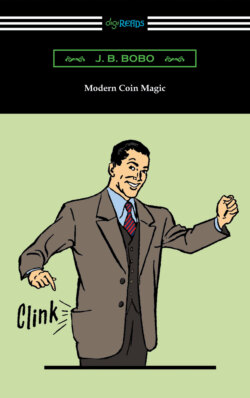Читать книгу Modern Coin Magic - J. B. Bobo - Страница 19
На сайте Литреса книга снята с продажи.
THE BACK THUMB PALM
ОглавлениеThe coin is clipped by its edge with the thumb and is concealed behind the hand, Fig. 1.
The moves necessary to get the coin into this position are harder to acquire than the Downs palm but this palm has the advantage of being considerably more angle proof. For this reason it is excellent for close work.
There are three ways to get a coin into this position. The first is a method used by T. Nelson Downs, while the other two are my own.
For the Downs method the starting position is the same as The Back Finger Clip, Fig. 1, (page 31). Bend the thumb down and clinch the fingers, Fig. 2. As you raise the thumb and return it to its normal position, move the coin along with it, Fig. 3, and clip it at the back of the fork of the thumb, Fig. 1. Straighten the fingers, keeping them slightly separated and show your hand empty, Fig. 4. Because the coin has a tendency to slant upward the hand must be tilted backward slightly to prevent the spectators getting a flash of silver.
The moves of transferring the coin from the back finger clip to the back thumb palm are made as you make an upward grab at an imaginary coin in the air. Feign disappointment as you open and show your hand empty.
Fix your eyes on another spot in the air even higher than before, then as you make a grab for it raise your thumb and allow the coin to slip into the clinched fist. Triumphantly open your hand and display the coin lying on your palm.
A simpler and easier method with less movement of the hand follows: Stand with your left side toward the spectators and display a half dollar between the tips of the first two fingers of your right hand as in The Thumb Palm, Fig. 2, or The Downs Palm, Fig. 2. Quickly lower, then raise your hand in a tossing motion, pretending to throw the coin upward into the air. Under cover of this movement, bend the first two fingers inward (in practically the same manner as you would for the thumb palm) and clip the coin behind the thumb. The main difference between this move and those used in the thumb palm is that the fingers must clinch tighter and the thumb must go under and not above the coin, Fig. 5. When the hand reaches its highest point it should be open and appear empty, Fig. 4.
Produce the coin as already described.
Another way of getting the coin into the back thumb palm is as follows: Stand with your right side toward the audience and display a half dollar between the tips of your right first two fingers, (The Thumb Palm, Fig. 2). Pretend to place the coin in your left hand but thumb palm it in your right, (the Thumb Palm Vanish, page 60). Close your left hand as if it actually held the coin, then swing to the right and show the right palm empty. It is under cover of this movement that the transfer of the coin from the thumb palm to the back thumb palm must be affected. Here are the moves: Bend the second finger inward, place its tip against the lower edge of the coin, then under cover of the swing to the right, push the coin upward between the thumb and base of the first finger and clip it in the orthodox back thumb palm.
This transfer is made while ostensibly showing the right hand empty, thus proving that the coin is actually in the left hand. Make no verbal comment as you do this—merely show the hand empty and turn your attention back to the left fist. Make crumbling motions with the left fingers, then open the hand and show it empty. Before attention returns to your right hand look up to your right and exclaim, “There it is!” Reach up with your right hand and produce the coin as already described, but do it with only one grab.
